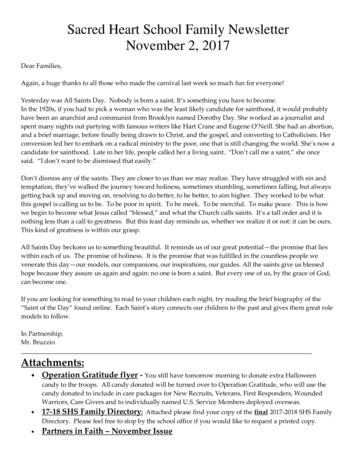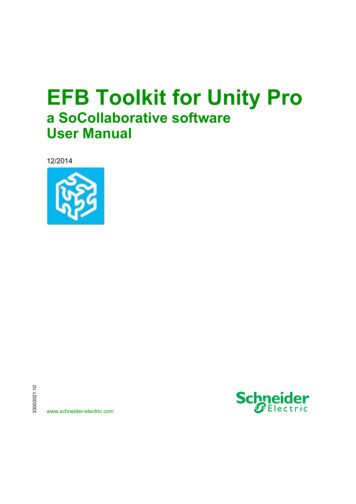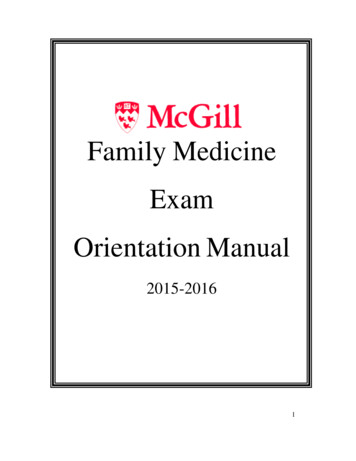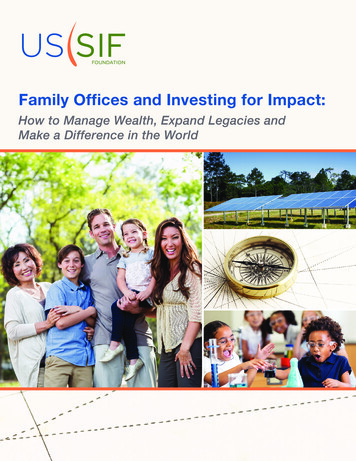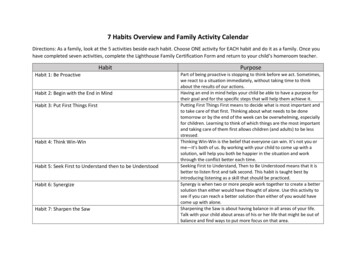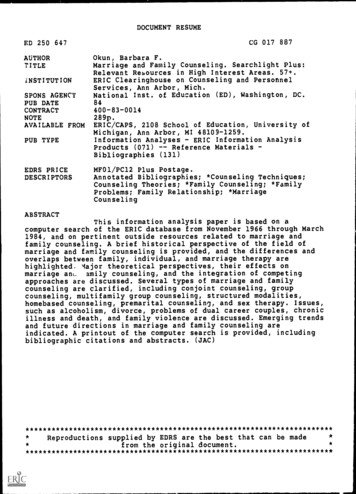
Transcription
UNITED FAMILIESINTERNATIONALA Guide to Family Issues:The Marriage AdvantagePublisherUnited Families InternationalWriting & ResearchMarcia BarlowEditingDennis DurbandGraphic DesignLarry Mishler August 2008United Families InternationalP.O. Box 2630, Gilbert, Arizona 85299-2630(480) 632-5450 Office / (480) 892-4417 FAXwww.unitedfamilies.org
IntroductionAbout the GuideThis publication includes peer-reviewed scientific research, expert commentary and soundlogical arguments regarding the societal benefits of marriage between one man and onewoman. In preparation for this publication, United Families International (UFI) reviewed a vastnumber of social science studies, books and other sources on the topic of marriage. Watch forupdates to this and other similar guides on topics impacting the family on UFI’s website:www.unitedfamilies.orgPosition StatementMarriage is crucial to society’s stability and its future. The weight of social science researchindicates that marriage provides unique benefits for a man, woman and the children resultingfrom the marital union. Marriage assures that children have access to a mother and a fatherand the unique contributions that both provide to child development. The research is clear andprofound: the fracturing of the natural family and the weakening of the institution of marriagecome with a very severe cost to society. The breakdown of the traditional family handicapsfuture generations.Revitalizing marriage should be a priority worldwide. Every nation stands to benefit from healthymarriages and healthy communities. Passing on to the next generation a happier, healthier andmore successful marriage culture carries with it clear and succinct benefits.United Families International respects the rights of individuals to freely associate. Werespect the noble efforts of single parents who strive to raise their children in less than idealcircumstances. While the research cited in this publication points to the overall advantagesexperienced by married biological parents, we acknowledge that a broad continuum ofoutcomes exists among all categories of parents. Nevertheless, it is incumbent upon publicpolicy makers to recognize the significant value added to communities by the marriageadvantage. Cost-benefit analyses and all things considered, marriage between a man and awoman is an essential asset that assures a productive and stable community.About United Families InternationalUnited Families International is a 501(c)(3) public charity devoted to strengthening the traditional family asthe fundamental unit of society at the local, national and international levels. UFI is a worldwide organization,accredited with the Economic and Social Council of the United Nations. UFI seeks (1) to educate government,community and religious leaders and citizens at the grass roots level on issues affecting the family and (2)to promote public policies and programs that preserve the traditional family.II
AcknowledgementsUnited Families International wishes to thank AssistantProfessor Brad Wilcox, a faculty member with the Universityof Virginia Department of Sociology, for his assistance inthe review of this booklet.We also express our gratitude to The Heritage Foundationand The Howard Center for Family, Religion & Society forpermitting the use of their charts and graphs.III
Table of ContentsExecutive Summary.1Foreword . . 2Questions & Answers about Marriage. 3Interest in Marriage . 4Married vs. Single . 5Marriage & the Workplace . 6Alternate Family Forms . 7Marriage Prevalence . 8Government & Marriage . . 9Same-Sex “Marriage”. 10Individual Happiness . 11The Key to Happy Marriage . 12Feminist Perspective . . 13Domestic Violence . 14Sex & Marriage . 15Cohabitation . 16Male/Female Roles . 17Single Parenting . . 18Lifetime Marriage . 19Marriage Education . 20The Future of Marriage . 21Fast Facts and Commentary .23Fast Facts and Commentary Index . .The Fundamental Nature of Marriage .Marital Happiness .Standard of Living .Violence and Crime . .Impact on Children .Better Physical Health/Longer Lives .Mental Health/Depression/Suicide .Marital Sex Life .Building Stronger Marriages .Public Perceptions of Marriage .Legal Precedent and Marriage . .252733364347586570737880Information Sources . . 82IV
Index of Charts1. – America’s Mid-Century “Culture of Marriage”*. 272. – The Retreat from Marriage*. 283. – International Marriage Comparisons, 2003 . 304. – Marriage Statistics* . 315. – Effect of Family Structure on Life Satisfaction: Australian Evidence . 336. – Married People are More than Twice as Likely to be Happy** . 337. – Living Below Poverty Line (By Percent) . 368. – Welfare Dependence Dramatically Increases Outside of Marriage**. 379. – Nearly 80 Percent of All Children Suffering Long-Term PovertyCome from Broken or Never-Married Families**. 3910. – Married Mothers are Half as Likely to be Victims of Domestic Violence**. 4311. – Adolescent Cocaine Use is Much More Common in Broken Families* . 4412. – Children from Single-Parent and Broken Families are MoreLikely to End Up in Jail as Adults** . 4613. -- Most Poor Children Reside in Single-Parent Families**. 4714. – Adolescents Suspended or Expelled from School . 4815. – Percentage of Children Who Ever Repeated a Grade in School . 5016. – Adolescents in Married Families are Less Likely to be Depressed**. 5117. – Family Structure at Age 14 and Later Out-of-Wedlock Childbearing** . 5218. – Adolescents are Less Healthy in Broken Families**. 5319. -- Risk of STDs .5820. – Divorced and Separated Adults are More Likely to Attempt Suicide**. 6521. – Canadians’ Criteria for Choosing a Mate . . 73*Courtesy of The Howard Center for Family, Religion & Society**Courtesy of The Heritage FoundationV
Executive SummaryMarriage is a unique, opposite-sex union with legal, social, economic and spiritual dimensions. It is a fundamental and universal social institution and the mechanism bywhich every known society seeks to obtain for each child the love, attention and resources of a mother and a father. The happiness, development and productivity of a newgeneration are bound to the marriage and the family unit. The successful developmentof children is critical to the success and preservation of nations. Because of marriage’sessential role, states and nations have chosen to provide unique benefits and incentivesto those who choose to be married.There is now broad bipartisan recognition that healthy marriage affords substantial benefits for adults and their children. Stable marriage has a positive effect on the economic,emotional and psychological well-being of men and women and dramatically benefitsthe well-being of children. A wealth of social science research attests to this conclusion. Efforts to uphold marriage between one man and one woman as the foundation forthe family – the fundamental unit of society – should be supported and strengthened.Families, communities and responsible governments should use all prudent means toencourage healthy, lawful marriage and to discourage pre-marital sex, out-of-wedlockchildbearing, adultery, divorce and alternative family forms.Marriage Leads to: Better health and greater longevityLess crime, less violenceSafer homesSafer communitiesLess poverty, more wealthHealthier societyBetter intimate relationsLess substance abuse and addictionLess hardship and better outcomes for childrenLess government, lower taxesMore happiness1
ForewordThis publication provides factual support, motivation andencouragement to responsible citizens and policy makersin the continuing effort to preserve and protect the traditionalfamily as the fundamental unit of society.This guide strives to serve the following purposes:To educate the public, government agencies, news media,non-governmental organizations, religious organizations,families and individuals on facts about marriage and theconsequences of marriage to individuals and society;To arm citizens with factual information enabling themto make informed decisions regarding relationships andfamily;To equip policy makers with research, facts and logicalarguments in favor of marriage; andTo provide a reference source to citizens for use inarticulating the benefits of marriage.The guide was also created to assist in advancing thedebate in the following scenarios: legislative debates school board meetings city council meetings preparing letters to the editor classroom debates educational term papers community involvement discussions with friends, family and neighborsThe section on Questions & Answers about Marriageprovides insights into the arguments frequently raised indiscussions and publicity about marriage.The section on Fast Facts & Commentary supports theQuestions & Answers section by providing peer-reviewedresearch, expert analysis and social science data regardingthe myths and misrepresentations surrounding marriage.2“The future belongs to thosepeople and cultures that deeplycommit to ideasgrounded in human nature: Menand women arenot interchangeable units; sexhas a meaningbeyond immediate pleasure,society needsbabies; childrenneed mothersand fathers; marriage is a wordfor the way wejoin men andwomen to makethe future happen.”Maggie Gallagher,President of the Institute for Marriage andPublic Policy, syndicated columnist and theauthor of three bookson marriage
Questions&Answersabout MarriageSupporting documentationand commentary can be foundin the Fast Facts & Commentary section3
INTEREST IN MARRIAGEQuestion 1Are people still interested in getting married?“A greatmarriage isnot when aperfect couplecomes together.It is whenan imperfectcouple growstogether andlearns toenjoy theirdifferences.”Dave Meurer,“Daze of ourWives; A SemiHelpful Guideto Marital Bliss”(Bethany HousePublishers:Minneapolis,Minnesota,(2000): 19.AnswerNinety-eight percent of never-married survey respondents said they wanted to marry, and 88 percent said thatmarriage should be a lifelong commitment.*Asked to select their top two goals, a majority of Americansincluded a happy marriage as a foremost goal. The numberone aspiration of high school seniors was “having a goodmarriage and family life.”** The proportion of high schoolseniors calling marriage and family “extremely important” hasrisen over the last two decades. Even cohabiting couplescast an eye toward marriage, as they mistakenly viewtheir domestic relationships as a precursor to a successfulmarriage. Numerous surveys show that most young peoplecontinue to aspire to life-long marriage and not to thedisposable marriages too often modeled by those in themedia spotlight.In an international survey, only 10 percent of Americansagreed that “marriage is an out-dated institution,” comparedto 26 percent in the United Kingdom and 36 percent inFrance. A majority of American high school seniors wantto get married -- 82 percent of girls and 70 percent ofboys agree that “having a good marriage and family life” is“extremely important” to them.**** National telephone survey of 1,503 Americans age 18 and older, (2004)** Monitoring the Future Survey, (1995)*** David Popenoe, The Future of Marriage in America, The National Marriage Project,(2007).See: Fast Facts and Commentary # 1-16, 156-1604
MARRIED VS. SINGLEQuestion 2To be happy, shouldn’t you just stay single?AnswerWhen it comes to happiness, married people have adecided advantage. A survey of 14,000 adults over a 10year-period found that marital status was one of the mostimportant predictors of happiness. According to the latestdata, 40 percent of married individuals said they were veryhappy with their life in general, compared with just less than25 percent of those who were single or cohabiting. Theseparated and divorced were the least happy group.*Married people reported the highest levels of well-being,regardless of whether they were happily married or not. Evenwhen controlling for relationship happiness, being married isassociated with higher self-esteem, greater life satisfaction,greater happiness and less distress.**Research in 17nations foundthat marriedmen andwomen reportsignificantlyhigher levels ofhappiness thanunmarriedpeople.Steven Stack andRoss Eshleman,“Marital Statusand Happiness: A17-Nation Study,”Journal of Marriageand the Family 60(May 1998): 527-530Married people are not only happier, they have better healthand financial resources as well. In looking at indicators ofwell-being, the data gives little support to the myth that singleadults lead better, happier lives.* Linda Waite and Maggie Gallagher, “The Case for Marriage: Why Married People areHappier, Healthier and Better off Financially,” (New York: Doubleday, October 2000): 67.** Claire Kamp Dush and Paul Amato, “Consequences of Relationship Status and Qualityfor Subjective Well-Being,” Journal of Social and Personal Relationships 22(5) (2005):607-627.See: Fast Facts and Commentary # 6, 17-19,21-23, 26-32, 41-45, 90-1295
MARRIAGE & THE WORKPLACEQuestion 3“Companiesworkingto becomeincreasinglyprofitable willdo well torealize that‘business’ takesplace insideand outsidethe workplace.Inasmuch asyour companyworks toincreaseproductivity,efficiency andprofitability,it’s smartto makemarriage anddivorce yourbusiness.”Matthew Turveyand David Olson,Marriage &Family Wellness:CorporateAmerica’sBusiness?A MarriageCoMissionResearch Report,Life Innovations,Inc., 2006Can business management afford to ignore the state ofmarriage among employees, or are healthy marriagesbeneficial to profit-driven organizations?AnswerAt first glance, it would appear that marriage and thebusiness world are distinctly unrelated. However, researchover recent decades reveals a different perspective. Buildingmarriages and strong families is not only good for individualsand communities, but it is good for a company’s bottomline. Successfully married individuals with stable familyrelationships contribute to increased profits in the workplace.Unhappy marriages and divorce among employees oftendecrease profitability.Employees in failing relationships can cost employers money.There are substantial productivity declines for workers in failingrelationships. These workers often have health concerns: increasedstress and anxiety, increased rates of depression and increasedrates of substance abuse. These workers directly cost companiesin higher healthcare expenditures and absentee rates and indirectlythrough the societal effects of broken families.Conversely, employees in successful relationships are morelikely to increase profits for their employers. These workers aremore stable, more committed to their employer and are oftenconsidered more dependable and motivated. Employees in healthyrelationships are also physically healthier, experiencing fewerchronic health problems like stress, anxiety and depression, savingemployers money in overall health care expenditures.In the interests of increasing profitability, employers will do well torealize that business takes place in the boardroom and the familyroom.* In short, happily-married employees are good for business.* M atthew Turvey and David Olson, “Marriage & Family Wellness: Corporate America’sBusiness?” A Marriage CoMission Research Report in conjunction with Life Innovations,(2006).See: Fast Facts and Commentary # 15-23, 38-45,90-1296
ALTERNATE FAMILY FORMSQuestion 4Since traditional marriage in the U.S. has been decliningfor a few decades, isn’t the logical course to follow theScandinavian model in which the government steps in toassist families by meeting the needs of both parents andchildren while promoting alternate family forms?AnswerIf countries choose to follow the Scandinavian model bypromoting and rewarding alternate family forms (singleparenting, cohabitation, same-sex unions) that break downtraditional marriage, their governments must also be preparedfor the inevitable rise in welfare costs.Government can never create enough social programs tocompensate for problems driven by premarital sex, out-of-wedlockchildbearing and failed marriages.The shoring up of traditional marriage is essential. Of the 150billion a year spent on various means-tested welfare programs inthe United States, 75 percent of that money goes to single parentsand individuals in non-traditional relationships. The increasingfrequency of alternative family forms does not justify governmentendorsement. The United States does not have a “welfare problem”so much as it has a problem related to the decline of marriage.Marriage researcher David Popenoe said that the United States ismoving in the direction of the weaker family structures of Europewhile lacking many of the welfare “safety-nets” found there, andthat the negative effects of marital decline on children will likely beheightened in America.See: Fast Facts and Commentary # 6, 26-129,140-155“When menand women failto form stablemarriages, thefirst result is avast expansionof governmentattempts tocope with thehigh cost insocial needsthat result.There isscarcely adollar that stateand federalgovernmentspend on socialprograms thatis not drivenin large partby familyfragmentation:crime,poverty, drugabuse, teenpregnancy,school failure,mental andphysical healthproblems.”Maggie Gallagher,“The Stakes,”National Review,July, 20037
MARRIAGE PREVALENCEQuestion 5Is it true that the majority of women in the United States todayare living without a husband?AnswerSeventy-threepercent of allwomen whohave reachedthe age of 30now occupya traditionalfemale role aseither wives orwidows.U.S. CensusBureau, 2005According to 2005 figures from the U.S. Census Bureau, aclear majority (56 percent) of all women over the age of 20were married. Moreover, nearly all women in the U.S. will getmarried at one time or another. Two-thirds of the women in the34-39 and 40-44 age groups were married. Among women 50 andover, 94 percent had been married at one time or another andsome 79 percent were either currently married or widowed.A 2007 media headline stated “Fifty-One Percent of All Women AreNow Living without a Spouse.” This deceptive us of U.S. censusdata included girls between the ages of 15 and 19, and womenwhose husbands were working out of town, in the military or whowere institutionalized. The misleading “51 percent” figure alsoincluded nine million elderly widowed women.The Census Bureau numbers clearly show that marriage is farfrom dead. Marriage is less common than it used to be, but thenumber of people who want to be married and those succeedingin marriage are still extraordinarily high. Nevertheless, the mediaportrays marriage as a collapsing, outmoded, dysfunctionalinstitution – despite its longevity and resilience.See: Fast Facts and Commentary # 1-118
GOVERNMENT & MARRIAGEQuestion 6Would it be better if the government got completely outof marriage? Why not leave the defining and support ofmarriage to individuals and churches?AnswerFor centuries, civil law around the world supported marriageas a necessary and fundamental social good. Marriage andfamily are the structural underpinning of all successfulsocieties. Marriage is the legal framework that ties men andwomen to the children their union creates; it is the logical andideal setting for nurturing and developing the next generation.Societies cannot assume that such a vital, life-sustaining entity asmarriage can be maintained without the support of governmentand the community, particularly in secularized society. Governmentdoes not depend upon churches and faith communities toassure the education of children or the maintenance of privateproperty because it is understood that the proper function ofgovernment is to produce educated citizens and to facilitateprosperous economies. Is marriage beneficial enough to societythat governmental, community and religious institutions should allsupport it? Clearly, that is why for centuries they have done so.Federaland stategovernmentsspend about 150 billioneach yearsubsidizingsingle-parentfamilies.Patrick Fagan,“EncouragingMarriage andDiscouragingDivorce”The HeritageFoundationBackgrounderReport, No. 1421,March 26, 2001Government involvement in marriage would not simply end withthe cessation of issuing marriage licenses. Government wouldcontinue to be heavily involved as taxpayer-funded public agenciespick up the pieces and engage in damage control when marriageeither does not occur or when marriage fails. Each year, thegovernment spends between 150 and 200 billion in subsidiesto single parents. Much of this expense could be avoided if themothers were married to the fathers of their children. Responsibleindividuals of all political persuasions acknowledge the importanceof marriage to the well-being of children, adults and society as awhole. They recognize that government has a long-established andlegitimate role in maintaining and supporting marriage.See: Fast Facts and Commentary # 15, 16,26-112, 165-1739
SAME-SEX “MARRIAGE”“Marriage is atthe center of thefamily, and thefamily is the basisof society itself.The government’sinterest inthe marriagebond, and thereason it treatsheterosexualunions ina mannerunlike all otherrelationships, isclosely relatedto the welfareof children.Governmentregisters andendorses marriagebetween a manand a womanin order toensure a stableenvironmentfor the raisingand nurturingof children.Social scienceon this matteris conclusive:Children needboth a mom and adad.”U.S. Senator SamBrownback, “DefiningMarriage Down,” July 9,2004, National ReviewOnline10Question 7Since marriage is about loving, committed relationships,should same-sex couples be allowed to enjoy all of thebenefits afforded by marriage?AnswerMarriage does not exist so that government can sanction andvalidate romantic relationships; civil marriage exists becausesociety needs children and it needs them raised in the mostoptimal environment possible. Tax breaks, subsidies and otherbenefits are conferred because society receives something inreturn. A stable marriage between a man and a woman is the onlyrelationship that has the biological potential to produce childrenand then provide the optimal environment in which to rear the nextgeneration. This is a societal and governmental imperative.Marriage is not an issue of love, rights or sexual preference. Allloving relationships are not equal, nor have they ever been so.United Families International respects the rights of people to freelyassociate as they wish, while also recognizing that marriage is notabout adult rights and adult benefits. Marriage is principally aboutthe bearing, nurturing and development of children. There is nomandate to ratify a “right” for some individuals that stands in directconflict with the equal right of children to have both a mother and afather.The same arguments that require legal recognition of same-sex“marriage” also require legal acknowledgement and protectionfor any consensual sexual practice or form of marriage. Oncethe significance of a union between one man and one woman isabandoned, there will be little -- if any -- principled ground uponwhich to deny marital status to group marriage, incestuous couplingor any type of loving relationship. Same-sex unions are not a minorchange to marriage, but represent a radical redefinition of the oneinstitution we know to be best for children.See: Fast Facts and Commentary # 14-16, 48,57-89, 156-160, 165-173
INDIVIDUAL HAPPINESSQuestion 8Is individual happiness the most important goal in life foradults? Do marriage and family hinder autonomy, individualityand the pursuit of happiness?Emotional fulfillment and individual happiness are importantand worthy goals, but they are not the only worthwhile goals.The quest for greater happiness and individual choice oftenclashes directly with the obligations and social norms thathold families together and enable communities to prosper.Children greatly benefit from healthy, intact marriages. Adulthappiness and well-being cannot trump the best interests ofchildren without consequences.“Marriage itself,detached fromany objectivefoundation, isseen by many aspossessing littleor no intrinsicworth but asbeing a meansto an end: theend, that is,of ‘personalhappiness’ or‘fulfillment.’In the questfor fulfillment,spouses andchildren areoften lookedupon not aspersons tobe loved andvalued for theirown sake butas objects tobe acquired,enjoyed, anddiscarded.”On measures of happiness and health, married people faredbetter than non-married persons. Many married persons find greatpleasure and fulfillment in raising children and sharing in their joysand successes. This family life often leads to further joys with thepresence of grandchildren. When individuals make sacrifices forthe benefit of their family, they report greater long-term happinessand self-fulfillment.William Bennett,“The BrokenHearth: Reversingthe MoralCollapse of theAmerican Family”(Doubleday: 2001):11-12AnswerThe self-fulfillment sentiment is articulated by the followingstatements:“As the economic necessity of it has become less pressing, peoplehave discovered that they no longer need marriage. It restrictsour choices and is too confining, which is why fewer people aremarrying.” -- Laura Kipnis, professor of media studies at NorthwesternUniversity“We no longer need a spouse for economic security or to[financially] take care of us when we get old. We can do thesethings for ourselves now.” -- Stephanie Coontz, professor of history at TheEvergreen State CollegeSee: Fast Facts and Commentary # 17-23, 38-5411
THE KEY TO HAPPY MARRIAGE“I didn’tmarry youbecause youwere perfect.I didn’t evenmarry youbecause I lovedyou. I marriedyou becauseyou gave me apromise. Thatpromise madeup for yourfaults. Andthe promise Igave you madeup for mine.Two imperfectpeople gotmarried andit was thepromise thatmade themarriage.And when ourchildren weregrowing up, itwasn’t a housethat protectedthem; and itwasn’t our lovethat protectedthem--it wasthat promise.”Thornton Wilder,“The Skin of OurTeeth,” (HarperPerennial ModernClassics: 2003)12Question 9Ninety-four percent of never-married singles agreed that“when you marry you want your spouse to be your soul mate,first and foremost.”* Is finding the right person – one’s soulmate -- to love and marry the key to a happy marriage?AnswerSearching for the “right person” facilitates the acceptabilityof disposable marriages and a perpetual search for that one,unique person. Rather than searching for one’s “soul mate,”the focus should be on developing character traits to be the“right person.”While love is an important component of a successful marriage,love alone is not enough. Marriage requires commitment,faithfulness, work and sacrifice. A couple can be successful inmarriage when each member: has done a reasonable job of selecting a like-minded mate; is committed to marriage in spite of the inevitable challenges; has developed effective communication and problem-solving skills; is more concerned about their spouse than themselves and hasdeveloped preservation and enhancement of love skills; and recognizes a commitment to past and future generations.Sexual attraction, while certainly important to marriage, is onlyone of many components that go into successful partner selection.Ideally, one is marrying not only a sexual partner, but also a bestfriend. The evidence of long-term marital success suggests thatpartners should be selected mainly on the
family; To equip policy makers with research, facts and logical arguments in favor of marriage; and To provide a reference source to citizens for use in articulating the benefits of marriage. The guide was also created to assist in advancing the debate in the following scenarios: leg
